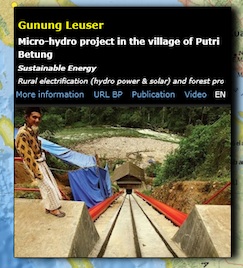A taste of development while preserving the forests in Gunung Leuser biosphere reserve.
 The thirteen villages in Puteri Betung Subdistrict did not have electricity. Some people and village institutions used generators to fulfill their daily needs of electricity. It was certainly costly and insufficient. Puteri Betung is located in between Blangkejeren main road and Kutacane that went through Gunung Leuser National Forest (biosphere reserve).
The thirteen villages in Puteri Betung Subdistrict did not have electricity. Some people and village institutions used generators to fulfill their daily needs of electricity. It was certainly costly and insufficient. Puteri Betung is located in between Blangkejeren main road and Kutacane that went through Gunung Leuser National Forest (biosphere reserve).
The project idea started with a reset conducted by BRR (Badan Rehabilitasi Rekonstruksi) Aceh-Nias with IBEKA (People Centered Business and Economic Initiative), an NGO for water-powered electricity.
Based on IBEKA’s research, there were a number of potentials to build micro-hydro plants in Gayo Lues, specifically in several points in Puteri Betung Subdistrict. Meanwhile, the demand for inexpensive electricity and sufficient had become an issue brought up by communities in the location and State Electricity Company could not fulfill the demand. BRR’s programmes had put the hydropower plants in various parts of Aceh as one of its development programme. RANTF (Recovery Aceh Nias Trust Fund) from the very beginning of its establishment had also proclaimed a specific program and allocated fund to the construction of environmental friendly and continuous electricity.
The first station was then built in Jamur Gele Village and continued with PLTMH in Puteri Betung Village, each with the capacity of 43 KVA and 2 X 180 KVA. The next project was to build a transmission that connected both hidropower plantes and flowed electricity to the six villages in Northern Gumpang and with its potential. Enterprises (Badan Usaha Antar Kampung, BUAK) were established by the community along with the construction of pmats, so that the electricity could be used for their main yields productions, such as candlenuts, patchouli and cocoa.
Micro hydropower plants are generally too small to be managed by the State Electricity Company (Perusahaan Listrik Negara, PLN), while on the other hand, the people had no experience in managing one independently. Therefore, prior to the development of the micro hydropower plant, the necessary information was disseminated and several community-enabling activities were conducted.
For houses situated outside the area that were served by the state electricity company, 50 watts of electricity per house was provided free of charge through a solar power plant. In the whole of Aceh province, 3,962 houses were served by solar power and several NGOs were reportedly also building similar solar power plants in Aceh and Nias.
The development of a new micro-hydro project in rural East Kalimantan is now underway.
Potential for Replication
The initiative to develop a new town like Beuramoe was eventually also proposed and implemented in other places and on different scales, for example in Singkil, and in Arongan (Lambalek) where housing areas were developed by CRS and BRR.
















